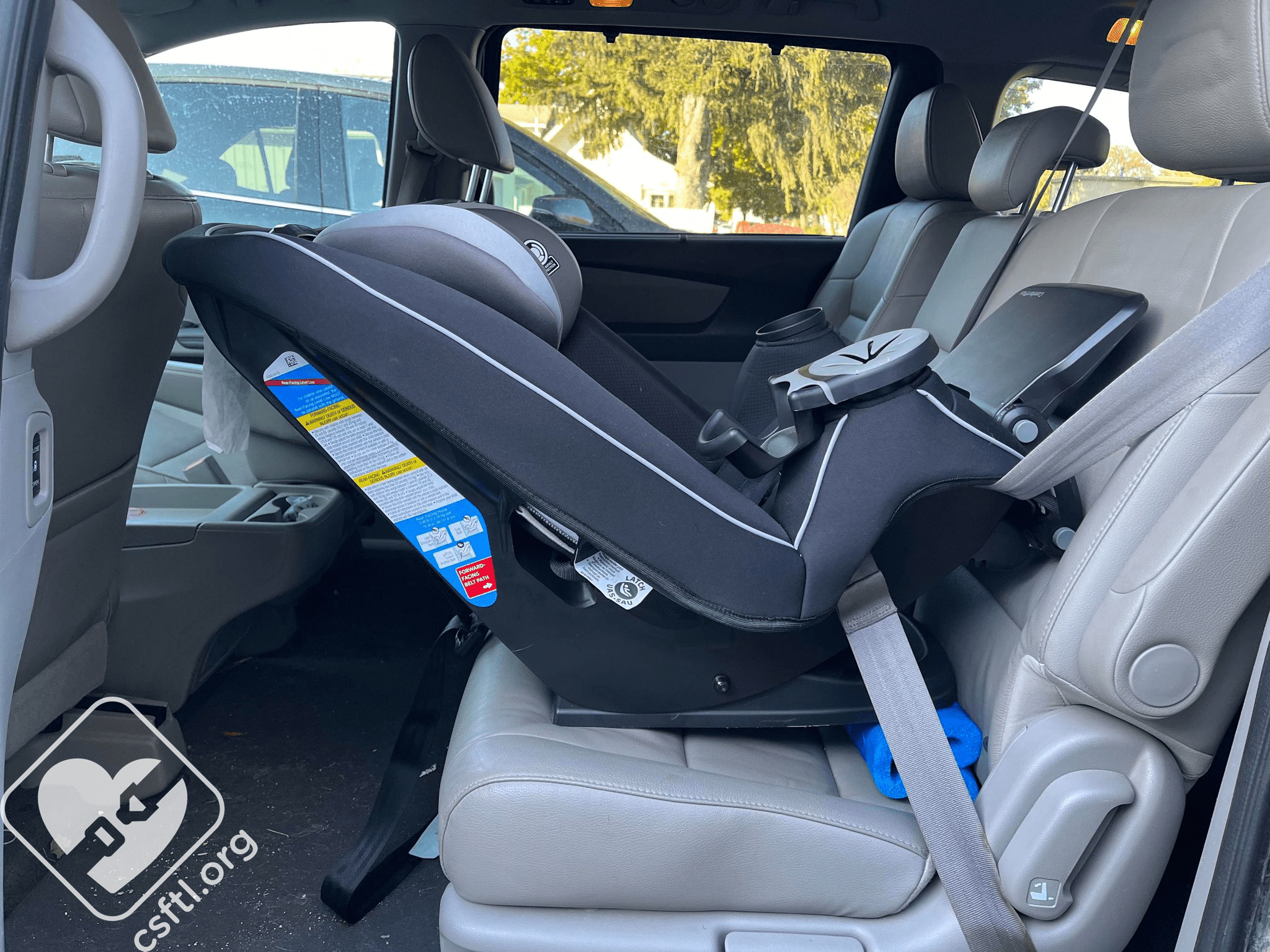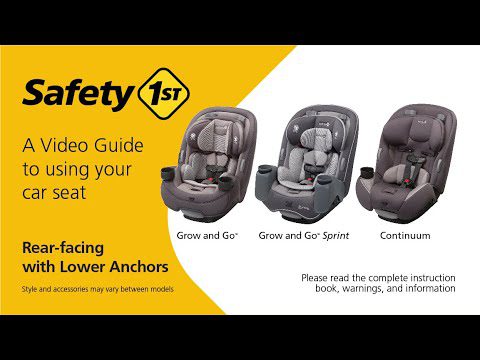To install a Safety First car seat, first read the manual, then secure the base using your vehicle’s seat belt or LATCH system. Ensuring your child’s safety is crucial, which is where the Safety First car seat comes in, offering peace of mind to parents on the road.
Selecting the right car seat and correctly installing it can significantly reduce the risk of injury in the event of an accident. With road safety a primary concern for all parents, understanding how to properly install a car seat is paramount.
The process involves specific steps that need to be followed meticulously to ensure maximum protection for your little ones. Whether you’re a new parent or a seasoned caregiver, grasping the basics of car seat installation is essential. Let’s walk through the process and provide helpful tips to make sure your Safety First car seat is installed correctly and securely.
Safety First: The Importance Of Proper Car Seat Installation
Ensuring the safety of our little passengers is a top priority for any parent or guardian. A key component of this is proper car seat installation. It may seem straightforward, but with so many types, models, and differing vehicle designs, installing a car seat correctly is crucial. It’s not just about following the manual step-by-step; it’s about knowing that your child is secure every time they buckle up. Let’s explore why proper installation cannot be overlooked and what statistics say about car seat safety.
Why Correct Installation Matters
Every parent wants to keep their child safe. A correctly installed car seat is vital. It becomes a child’s best protection on the road. Let’s examine this in detail:
- Protects in a crash: A well-installed seat can mean the difference between safety and injury.
- Ensures optimal functionality: Safety features work best when the seat is installed as the manufacturer intended.
- Peace of mind: Knowing the seat is proper gives confidence during travel.
Statistics On Car Seat Safety
The numbers highlight the importance of proper car seat installation:
| Statistic | Impact |
|---|---|
| Correct use reduces injury risk by 71–82% | Higher survival rates in accidents |
| Over 90% of new parents make mistakes | Mostly due to incorrect installation or harness use |
This table shows concrete reasons why every guardian must focus on learning the exact installation process and checking the car seat before every trip.

Credit: csftl.org
Choosing The Right Safety First Car Seat
Securing your little traveler is paramount when on the road. Safety First car seats provide a shield of protection around your cherished cargo. It is crucial to choose the perfect seat. The right one fits your child’s size, age, and your vehicle’s interior. Let’s dive into the different models available and how to find the best match for your child.
Various Models And Their Features
Safety First offers a variety of car seats designed to grow with your child. Each model has unique features tailored to different stages of your child’s growth. Here’s a snapshot:
- Infant Car Seats: rear-facing design, ideal for newborns and small babies.
- Convertible Car Seats: Can switch from rear-facing to forward-facing. Perfect for growing toddlers.
- Booster Seats: For older children who need a lift to properly fit the vehicle’s seat belt.
Detailed specifications for these models ensure a perfect fit and the utmost safety. Key features like side-impact protection, adjustable harnesses, and comfort padding set these seats apart.
Identifying The Right Seat For Your Child
Selecting the ideal car seat depends on your child’s age, weight, and height. Safety First caters to all stages, ensuring peace of mind during each journey.
| Child’s Age | Weight Range | Height Range | Recommended Seat |
|---|---|---|---|
| 0-2 Years | 4-40 lbs | Up to 35 inches | Infant Car Seat |
| 2-4 Years | 22-65 lbs | Up to 50 inches | Convertible Car Seat |
| 4+ Years | 40-100 lbs | Up to 57 inches | Booster Seat |
Checking your car’s compatibility with the seat is also a must. Ensure the seat fits well, leaving no room for error in the event of sudden stops or sharp turns.
Before You Begin: Preparation Steps
Installing a safety first car seat properly is crucial for your child’s safety on the road. Before diving into the installation process, let’s prepare thoroughly. These initial steps ensure a smooth and secure fit for your little one’s journey ahead.
Reading The Manual: A Must-do
Never skip reading the car seat manual. It’s the ultimate guide to the correct installation. The manual contains essential information tailored to your specific model. It answers all your questions about the car seat’s parts and installation methods. Familiarize yourself with the manual before moving further. It’s a step that ensures your child’s safety is not compromised.
Gathering The Necessary Tools
- Vehicle owner’s manual: To understand the seat belt or LATCH system.
- Car seat manual: For specific installation instructions.
- Latch connectors or seatbelts, depending on your installation method.
Gather these items before you start. Having everything handy makes the installation process a breeze. Remember, some car seats also require a tether, so check your manual. A proper installation protects your precious passenger every mile of the road.

Credit: m.youtube.com
Step-by-step Installation Process
Welcome to the Step-by-Step Installation Process of Your Safety First Car Seat. Ensuring your little one’s safety is paramount. Follow these simple instructions to correctly install the car seat. It’s easy, quick, and crucial for your child’s well-being.
Securing The Base
- Place the base in your car’s back seat. Ensure that it rests flat on the seat.
- Use your car’s LATCH system or the seat belt to secure the base. Choose only one method.
- If using LATCH, connect the hooks to your car’s lower anchors.
- Press down firmly on the base.
- Pull the straps to tighten.
- If using a seat belt:
- Thread the belt through the base’s designated belt path.
- Buckle the belt.
- Press down firmly and tighten.
- Check the base for movement. It should not shift from front to back or side to side by more than an inch.
Attaching The Seat
- Align the car seat with the base. Keep the back of the car seat facing the front of your car.
- Press the car seat down into the base until you hear a click. This indicates it’s latched on correctly.
- Perform a pull test. Tug on the car seat to ensure it’s secure.
- Adjust the harness so it’s snug against your child’s body.
- Do a final inspection. Verify that the car seat is at the correct recline angle. Use the level indicator as a guide.
With these steps, your child’s Safety First Car Seat is now properly installed. Always consult your car seat and vehicle manuals for specific instructions. A secure installation is vital for your child’s protection in the car.
Post-installation: Safety Checks And Adjustments
Congratulations on installing your new Safety First car seat! Now comes the crucial part: the post-installation checks. To keep your little one secure on the road, perform these vital safety assessments.
Ensuring Proper Fit And Security
Every car seat must hug your car’s back seat tightly. A properly fitted seat should not shift from front to back or side to side more than an inch. Check the fit around the area where the car seat belts or lower anchors connect.
Next, ensure the harness is snug on your child. You should not be able to pinch any slack between your fingers when testing the harness straps over your child’s shoulders.
Quick Checklist:
- Seat Movement: Less than one inch
- Harness Check: No slack pinching
How To Test The Installation
Testing your car seat installation ensures everything is set perfectly. Give the base of the seat a firm shake at the belt path. Do this with the same force as tightening your seatbelt. A secure seat stays put with minimal movement.
Here’s how you can test the installation:
- Grasp the base of the seat at the belt path.
- Shake it side-to-side and front-to-back.
- Assess for movement; it shouldn’t exceed one inch.
If the seat moves too much, recheck the installation steps. Tighten the seat belts or lower anchors as needed.
Maintaining Your Car Seat Over Time
Keeping your Safety First A car seat in top condition is vital. Over time, it’s not just about cleanliness; it’s safety too. Remember, a well-maintained car seat protects your little one on the road. So, let’s dive into maintaining your car seat with a couple of key aspects to focus on.
Regular Check-ups And Adjustments
Just like your car needs servicing, so does your seat. Make it a habit to regularly inspect and adjust your Safety First car seat.
- Examine the straps: Look for signs of wear and tear. Ensure they’re not frayed or twisted.
- Check the buckles. They should click securely. Clean out any crumbs or debris that might hinder their function.
- Revisit the fit: As your child grows, adjust the harness and headrest. The car seat manual will guide you through this.
Finally, if you’re in doubt, a certified car seat technician can help. They offer inspections and can teach you about proper car seat maintenance.
When To Upgrade To A Bigger Seat
Children grow quickly, and so should their car seats. Knowing when to switch to a larger car seat is crucial for your child’s safety.
| Weight | Height | Age |
|---|---|---|
| Exceeds seat limit | Shoulders above top harness slot | Typically around 2 years or older |
When your child’s growth outpaces their current seat, it’s time to upgrade. Your car seat manual lists weight and height limits. Check it against your child’s current stats to decide.
Common Installation Mistakes To Avoid
Welcome to the critical phase of ensuring your child’s safety—installing their car seat correctly. It may seem straightforward, but many parents unknowingly make mistakes that can compromise the safety of their little ones. Let’s navigate the common pitfalls and learn how to sidestep them for a secure ride every time.
Frequent Missteps Explained
In the journey of car seat installation, certain missteps are more common than others.
- Ignoring the car seat manual: The guide is your roadmap to correct installation.
- Using both LATCH and seat belt: Choose one method, not both.
- Not securing the car seat tightly: It should not move more than one inch.
- Placing the car seat at the wrong angle: Ensure proper positioning for infant seats.
- Incorrect strap placement: Harness straps should be at the right height and snug.
Tips For Avoiding Common Errors
Evading these errors can be simpler than one might think. Let’s dive into some practical tips.
- Study the manual: Spend time with your car seat’s manual before diving in.
- Choose the right installation method. Decide on LATCH or seat belt, then follow the steps.
- Perform the pinch test: After installation, tug at your car seat. Ensure it doesn’t move more than one inch.
- Monitor the recline angle: For infant seats, use the built-in angle indicator or adjuster.
- Check the harness. Harness straps should lie flat without any twists.
Remember, taking these steps seriously is not just about following instructions; it’s about keeping your child as safe as possible on the road.
Expert And Community Resources For Assistance
Ensuring your child’s car seat is properly installed is crucial. Expert and community resources offer valuable assistance. Find help online or consult a professional.
Utilizing Online Forums And Guides
Online forums and guides provide step-by-step assistance. They are easily accessible. It is helpful for parents to install a car seat. Use these resources to get it right.
Search for video tutorials for visual guidance. Follow instructions from safety experts. Check popular parenting forums for advice.
Look for:
- Instructional videos on YouTube
- Discussions on parenting websites
- Q&A sections on car seat manufacturer sites
Seeking Professional Help If Needed
Sometimes, you may need a pro. This is nothing to shy away from. Certified technicians can ensure safety. They’ll guide you through the process.
Find local car seat inspection events. Use the National Highway Traffic Safety Administration (NHTSA) site to locate experts.
| Service | Description | Contact |
|---|---|---|
| Local Car Seat Check | Get your installation checked by experts. | Visit the NHTSA website for locations |
| Fire Stations or Police Departments | Often offer free car seat checks. | Call ahead to schedule an appointment |
Don’t hesitate to seek help. A car seat’s safety is worth the effort.

Credit: www.amazon.com
Frequently Asked Questions Of How To Install Safety First Car Seat
How Do You Install A Car Seat Step By Step?
Start by selecting a compatible car seat for your vehicle’s make and model. Place the car seat in the back seat, following the angle guidelines for your child’s weight and height. Secure the seat using either the LATCH system or the car’s seat belt.
Ensure the seat is snugly fit with no more than an inch of movement side-to-side. Lastly, double-check all connections and consult the manual for specific instructions related to your car seat and vehicle.
How Do I Make Sure My Car Seat Is Installed Correctly?
To ensure correct car seat installation, consult the manual, use the correct seat for your child’s age and size, secure it tightly to the vehicle, check the harness for snugness, and consider a professional inspection for assurance.
What Are The Common Mistakes When Installing A Car Seat?
Common car seat installation mistakes include not securing the seat tightly, incorrect seat angle, improper use of seatbelt or LATCH system, wrong harness slot usage, and not regularly checking for recalls or expiration dates.
How Do You Install A Safety First Jive Car Seat?
To install a Safety 1st Jive Car Seat, start by reading the manual for specific instructions. Position the seat rear-facing for infants or forward-facing for toddlers. Secure it tightly with your vehicle’s seat belt or LATCH system, and ensure it’s properly leveled and tightened.
Conclusion
Ensuring your child’s safety during car travels starts with proper car seat installation. With this guide, we hope to make the procedure understandable and doable. Remember, routine checks for secure fittings add an extra layer of safety. Drive with peace of mind, knowing your little one is safely secured in their Safety First car seat.
I am an Car technician and writer I write article based in USA. I have over 12 years of experience about car servicing car repairing. I will try to share all my experience through this website.

